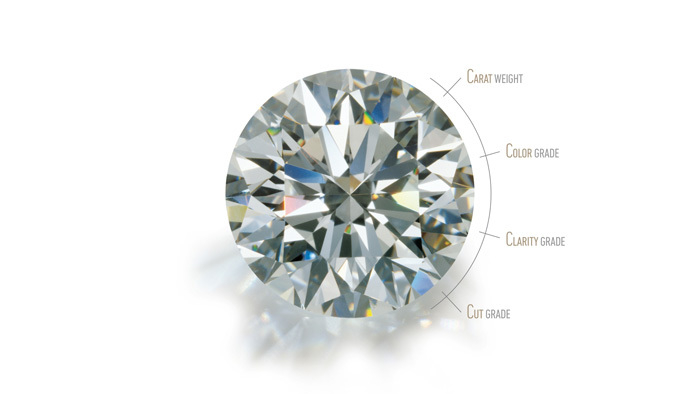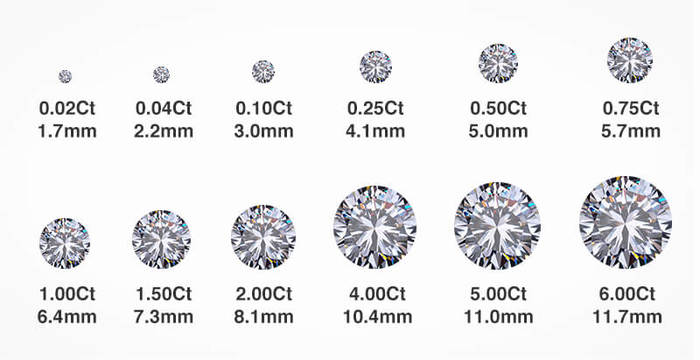Diamond Education: The 4-C's
July 24th, 2019
When it comes to diamond education, it wasn't until the middle of the twentieth century that a standard guideline for judging diamonds was created. Thanks to GIA, understanding the 4Cs of Diamond Quality (color, clarity, cut, carat weight) has never been easier. Today, diamond quality is communicated in a universal language and now buyers can know exactly what they are about to purchase.
So before you begin looking for that unique engagement ring, it is important that you know how to choose the perfect diamond. To set you on the right path, let us first begin by breaking down the four C's of diamonds and explain the importance of each category.

Cut
The diamond cut is the most important element to consider when buying a diamond. The cut is the biggest factor in creating sparkle and fire, and without a high cut grade even a diamond of high quality can appear dull and lifeless. When diamond cuts are made with the proper proportions, light is returned out of the top of the diamond (which gemologists refer to as the table). If the cuts are too shallow, light leaks out of the bottom; too deep and it escapes out of the side. A diamond cut poorly and too deep can face-up smaller than it actually is.
So to maximize your budget, choose the highest diamond cut grade your budget allows. We suggest a cut grade of Excellent.
Color
After diamond cut, diamond color is the second most important characteristic to consider when choosing a diamond. The highest quality diamonds are colorless, while those of lower quality have noticeable color, which manifests as pale yellow in diamonds.
From white to yellow, diamonds receive a grade for the amount of color they contain. Diamond buyers prefer colorless to near colorless diamonds. The Gemological Institute of America (GIA) grades diamond color on a scale of D (colorless) to Z (light yellow or brown).
There are six categories on the GIA diamond chart, with color grades that range from absolutely colorless to light in color. Diamonds rated D are the most devoid of color and very rare, whereas G color diamonds and H color diamonds are near colorless, and since they?re priced lower they are excellent value diamonds. The more you move down the color chart, the lower the color grade is, and the more noticeable the light yellow hue becomes.

Clarity
Clarity describes the clearness or purity of a diamond and is the assessment of small imperfections on the surface and internally. A grade is assigned to each diamond, with "F" representing a flawless diamond to "I" describing a diamond that has inclusions. Diamonds with the least and smallest inclusions receive the highest clarity grades.
Diamond clarity is the least important factor when choosing to buy a diamond because most diamonds have blemishes and small inclusions that are microscopic, unable to be seen with an untrained or unaided eye. Diamond buyers will sometimes choose a gem with some inclusions, as long as they are not visible to the naked eye. These tiny, natural blemishes and inclusions are usually microscopic and do not affect a diamond?s beauty in any way.
Carat
Carat refers to the weight of the diamond. Diamond carat is often misunderstood and refers to a diamond's weight, not necessarily its size. A carat is measured in increments called points. One carat is equal to 100 points. Carat weight is the easiest of the 4C's to determine because it is measured on a diamond scale. Two diamonds of equal weight can have very unequal value depending upon the cut, color and clarity of each. The larger the carat, the pricier the diamond, although the other "C's" can influence the final price significantly.
When comparing diamond carat sizes, take a diamond's cut into consideration as well: a high-carat diamond with a poor cut grade may look smaller, often cut deeper, than a diamond with smaller carat weight and a better cut. Very small differences in carat weight can sometimes result in a disproportionate cost. To the naked eye, the difference between a 1.10 carat and 1.20 carat diamond might be impossible to discern, but the cost difference between those carat weights can be significant for otherwise comparable diamonds.

Tips to remember when buying a diamond:
Before choosing your perfect engagement ring, make sure you have a comprehensive understanding of diamonds- from their structure to the 4C's. To start, keep these simple tips in mind.
- Don?t Obsess Over Size or Perfection: Carat is the most misunderstood of the 4Cs. It actually refers to a diamond's weight, not the diamond?s size. When selecting a diamond, don?t focus on one category alone. For example, consider cut and carat together; a larger carat diamond with a poor cut grade can appear smaller than a smaller diamond with a higher cut grade.
- Maximize Your Budget: "Buy Shy," which means selecting a carat weight slightly below the whole and half carat marks. For example, instead of a 2.0-carat diamond, consider buying a 1.9-carat weight. This will save a considerable amount of money and the slight size difference will never be noticed.
- Talk to an Expert: When it comes to selecting the perfect diamond, let the experts at W. Kodak Jewelers help. Schedule an appointment to discuss your budget and diamond preferences so that you maximize your time and budget.
SCHEDULE A DIAMOND CONSULTATION TODAY! CONTACT US